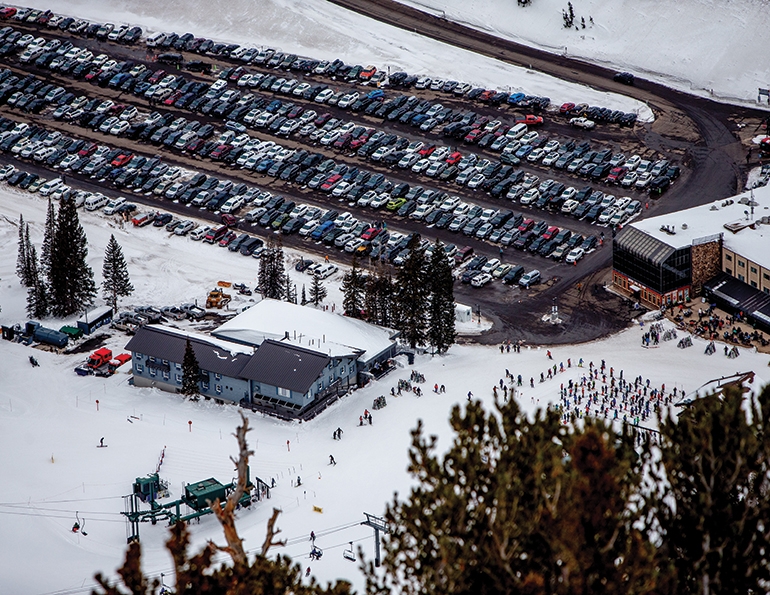Last winter, thanks in part to a series of big Friday storms, the parking lots at Alta Ski Area, Utah, filled to capacity on more than a dozen different days, leaving skiers—including season pass holders—with no other option but to drive back down Little Cottonwood Canyon. “It pushed us beyond what we’ve ever seen before,” recalls Alta communications manager Andria Huskinson, who helped out with traffic control. “One Saturday we were full by 8:30 a.m.”
The last thing any ski area wants to do is turn away business. But whether it’s due to maxed-out parking lots, congested or closed roads, or even guests who simply give up in frustration when traffic slows to a crawl miles away, access to the slopes has become a matter of urgency at many U.S. resorts, especially those near large drive markets.
The good news? From paid parking and carpooling incentives to better bus service and innovative technology, ski areas have been implementing various measures to address the problems. Many of these strategies also address environmental concerns related to vehicle emissions, and some may bring in additional revenue.
INTRODUCING PAID PARKING
Unlike last winter, when resorts used parking as a tool to restrict the number of on-mountain guests amid pandemic protocols, this season’s approach is more about managing the volume of cars and the arrival experience. “How you arrive affects the way you look at the day,” notes Adam Sutner, VP of business development at Crystal Mountain, Wash. The area just introduced paid parking ($20–$30) for non–season passholders Friday through Sunday and on holidays.
Many of the resorts we spoke to have either instituted parking fees for the first time this winter (generally on the busiest days) or increased the number of paid spots. For ski areas in the East, where standard parking has traditionally been free, that’s a big change. “Paid parking is coming to the East,” says Michael Bisner, VP of sales for Axess North America, an RFID-enabled technology provider, which offers integrated parking technology in addition to lift access and automated pick-up boxes.
Contactless solutions. Already widely used in Europe, the Axess parking system debuted in North America this winter at the Caledon Ski Club, a private resort near Toronto, and Bisner says several U.S. resorts plan to adopt it next winter. The system uses an RFID-enabled gate that guests can access with a swipe of their ski pass and license plate recognition for online payments.
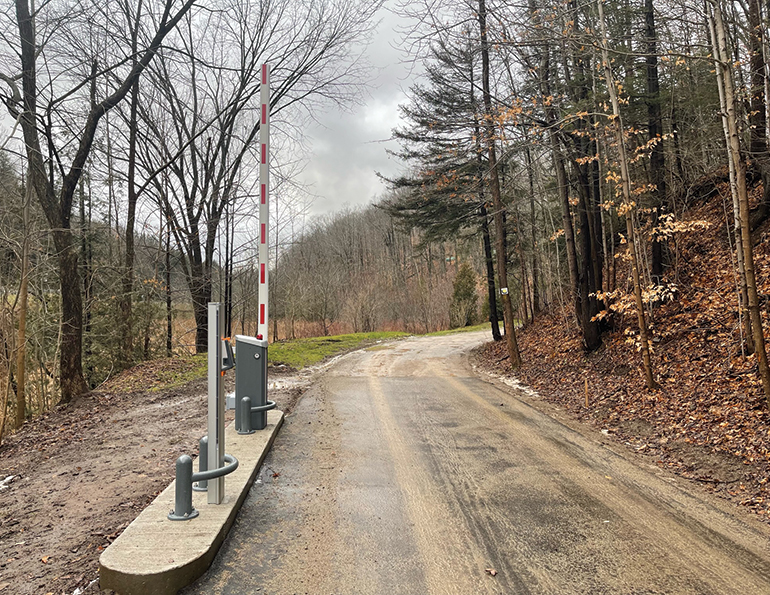 The new RFID-enabled parking gate at Caledon Ski Club allows customers to use their ski pass to enter.
The new RFID-enabled parking gate at Caledon Ski Club allows customers to use their ski pass to enter.
At Mount Snow, Vt., which said this past summer that 44 percent of its spaces will require fees at peak times in winter, guests pay for parking via the Passport app. Resorts that partner with Denver-based Interstate Parking—which, among others, include Solitude, Utah, Northstar, Calif., Breckenridge, Colo., and Crystal Mountain, Wash., as well as several ski towns—use variations of the vendor’s solar-powered self-pay kiosks, posted QR codes, and online payments through customized websites, all of which rely on license plate information. Interstate also provides staff to check license plates during the day for compliance. This type of contactless service, which Covid helped catalyze, alleviates a traditional paid parking pinch point: in-person transactions with a booth attendant.
Improving flow. Unsurprisingly, there’s been some guest pushback to the proliferation of paid parking, but Mount Snow, for one, says increasing its paid parking was a necessary step to improve arrival on busy days. The resort had already been charging skiers to park in its two slopeside lots ($15–$30 daily). But as everyone else vied for the closest-in free spots, says Adam White, Vail Resorts’ senior manager of resort communications for the Northeast, traffic backed up on the access roads and “people were having to sit in their cars for a really long time.” In order to disperse more guests among the farther-out lots (a five-minute walk or a shuttle ride to the base), the resort now charges $15 on weekends and holidays to park at its four closer-in lots.
White admits that Mount Snow’s parking changes are not popular among the resort’s skier base; the resort responded with having customer service reps gradually reach out to passholders and also field calls from guests. “We’ve really tried to make it a dialogue,” he says. “People want to feel like they’ve been heard.”
Pricing tiers. In 2019, Solitude was the first Utah ski area to introduce paid parking in all of its lots. The area uses a tiered scale—the more people in a car, the lower the cost. Sundance launched a similar plan this winter, but only on peak days.
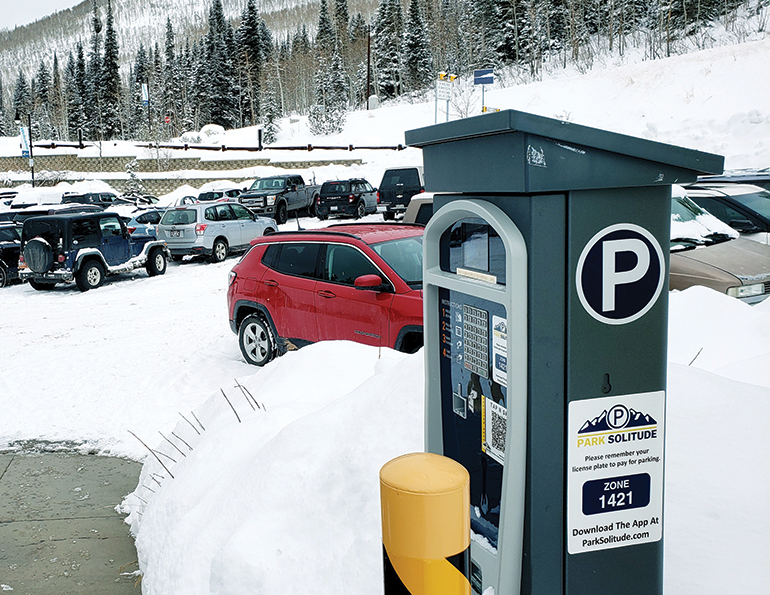 Solitude, Utah, utilizes solar-powered self-pay parking kiosks.
Solitude, Utah, utilizes solar-powered self-pay parking kiosks.
As for Alta, the resort hopes that requiring paid reservations on weekends and holidays will help solve its vehicle capacity issues. The tiered system allows season pass holders to reserve for free, while lift ticket purchasers receive a discount code. Ikon and Mountain Collective pass holders, plus the growing number of backcountry skiers who use Alta’s lots, pay the full $25 fee.
Down the road at Snowbird, where parking spots are more plentiful, the resort added the option to reserve parking online ($10–$20) for those who want the guarantee of a close-in spot.
“It’s all about changing behavior,” says Gareth Lloyd, Interstate’s executive VP and operating partner, noting that “the biggest impact we’ve had on the resorts we work with is carpooling.”
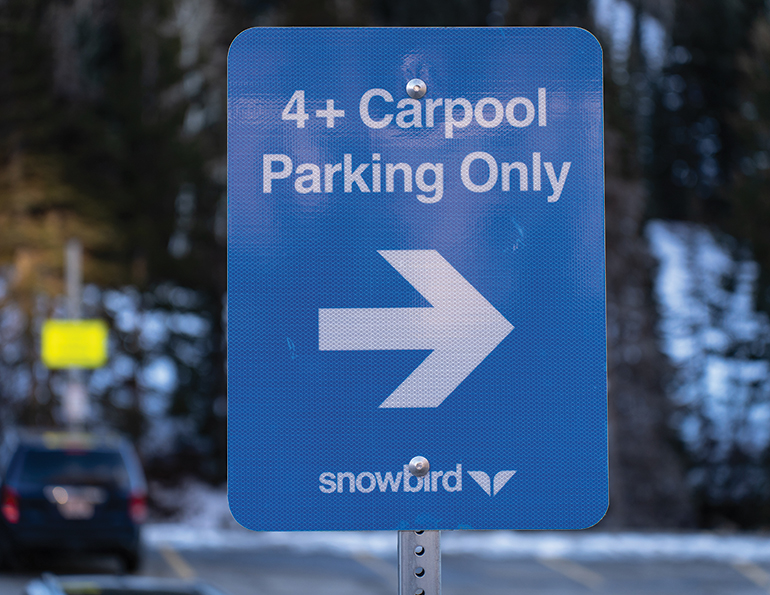 Snowbird, Utah, offers preferred parking to carpoolers.
Snowbird, Utah, offers preferred parking to carpoolers.
CARPOOL STICKS AND CARROTS
“One thing that gets people to change habits is hitting them in the pocketbook,” says Bisner. That seems to be the premise informing the latest parking initiative at Eldora, Colo.
The resort’s proximity to the metro areas of Denver and Boulder has resulted in increasing traffic woes, with lots filling up early and skiers being turned away. “We still had plenty of room on the slopes,” says marketing director Sam Bass. “Parking was our limiting factor.” The area recently received county permission to add another 800 parking spots to its 2,000 existing ones, with completion slated for next summer. As part of the approval, Boulder County asked Eldora to charge single-occupancy vehicles $10 to park on weekends and holidays; as parking is otherwise free, it’s a deterrent to not carpooling.
Ski areas are developing non-monetized ways to incentivize carpooling, too. Crystal Mountain newly provides dedicated carpool lots, which have a prime location and more frequent shuttle service—what Sutner calls “VIP parking for carpoolers”—where groups of four or more park for free. At day’s end, guests can ski or ride right back to their cars. Crystal eventually hopes to add more amenities to the carpool lots, like portable bathrooms and coffee service.
Messaging change. A key to successful carpool introduction: effective communication. In 2018, when Eldora tried to encourage carpooling a month into the season by charging cars with fewer than three passengers $20 to park on peak days, the outcry was swift, and loud. Guests didn’t appreciate having the rules changed on them partway through the game, and the resort ended up shelving the effort. This time, Eldora promoted the new fee early on, says Bass, and reaction has been more favorable.
Likewise, when Crystal introduced carpooling two years ago after a mid-season surge in business, the makeshift solution wasn’t widely welcomed. Now, “we’ve put all of our learning and knowledge together and rolled this out as a big strategic initiative,” says Frank DeBerry, president and COO of Crystal and COO for Alterra’s Western region. The initiative includes paid parking, additional EV charging stations, and enhanced dedicated bus service.
NUDGING GUESTS TOWARD BUSES
Buses can be tricky, as there’s still the inherent schlep factor, especially for families hauling all of their gear and themselves to the slopes. Nonetheless, some resorts have renewed efforts to encourage use of public transport. At Mount Snow, southern Vermont’s free regional bus, the Moover—painted like a Holstein cow—is “tragically underused,” says White. The ski area hopes its new parking fees will incentivize more skiers to ride the bus instead.
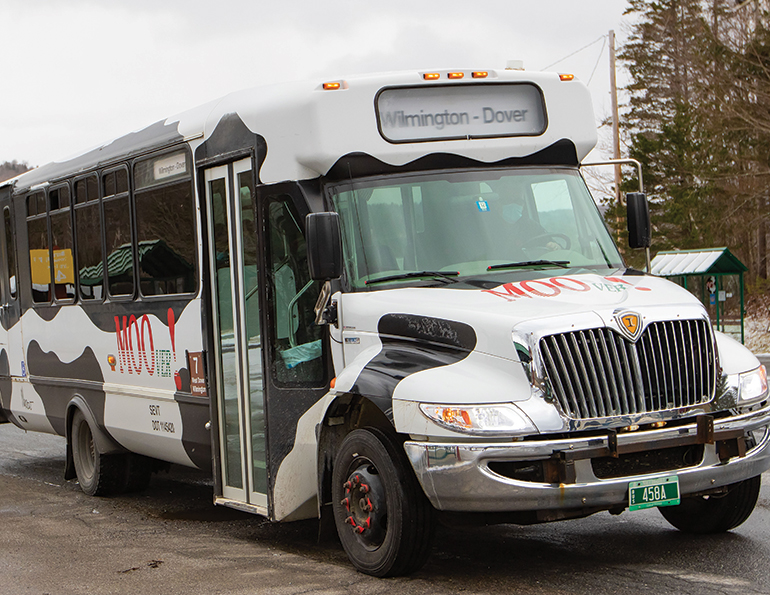 Vermont’s free Moover bus is underutilized, something Mount Snow hopes will change with its newly implemented paid parking.
Vermont’s free Moover bus is underutilized, something Mount Snow hopes will change with its newly implemented paid parking.
And after a pandemic hiatus, the Snowstang bus, run by Colorado’s department of transportation, resumed its once-daily weekend runs ($25–$40 round-trip) from Denver to four ski areas. The service debuted in 2019 and has proven popular.
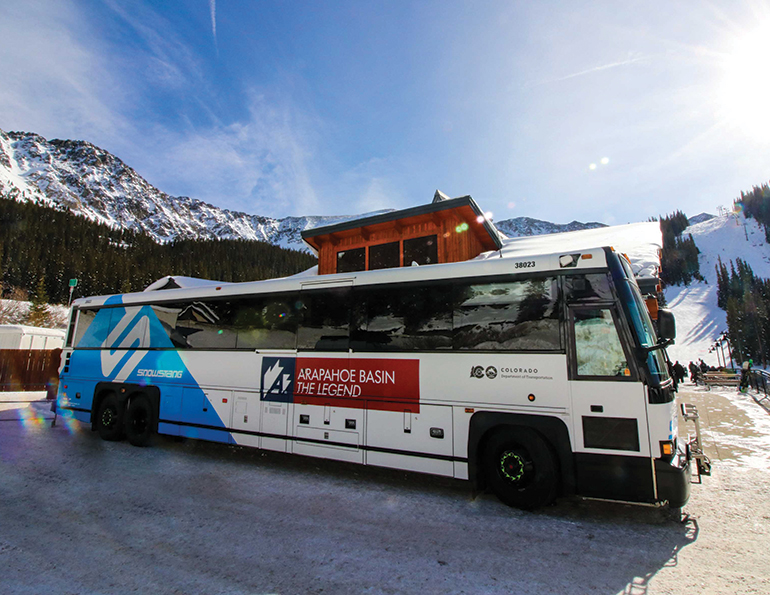 The Snowstang shuttle offers weekend rides from Denver to Arapahoe Basin and other resorts.
The Snowstang shuttle offers weekend rides from Denver to Arapahoe Basin and other resorts.
Dedicated shuttles. Dedicated shuttles, like Crystal Mountain’s 56-seat luxury coaches, seem promising. Crystal’s coaches ferry skiers some 40 miles from the town of Enumclaw up the curvy, two-lane state highway to the ski area. Guests can park for free, and the buses depart twice on Fridays and Sundays, and six times on Saturdays.
All revenue from the ski area’s paid parking funnels directly into the bus program, which requires a yearly investment of between $200,000–$300,000, says Sutner. Through its research, resort management believes this option appeals more than taking, say, a 6:00 a.m. bus from Seattle, about two hours away; early guest feedback seems to confirm that.
Similarly, on weekends and holidays, Eldora runs free 22-passenger shuttles from the town three times a morning. The area also gifts tickets for the public bus from Boulder, 40 minutes away. Both initiatives increased in amount and frequency this winter as part of the resort’s new parking-expansion approval.
Stowe Mountain Resort, Vt., has installed a decomissioned gondola cabin as a shuttle stop in town to build awareness about its free shuttle that services the seven-mile, two-lane road between the resort and the village. The cabin provides shelter from the elements and aims to appeal to the selfie-takers around town, while nearby signage educates visitors about the shuttle’s schedule and stops.
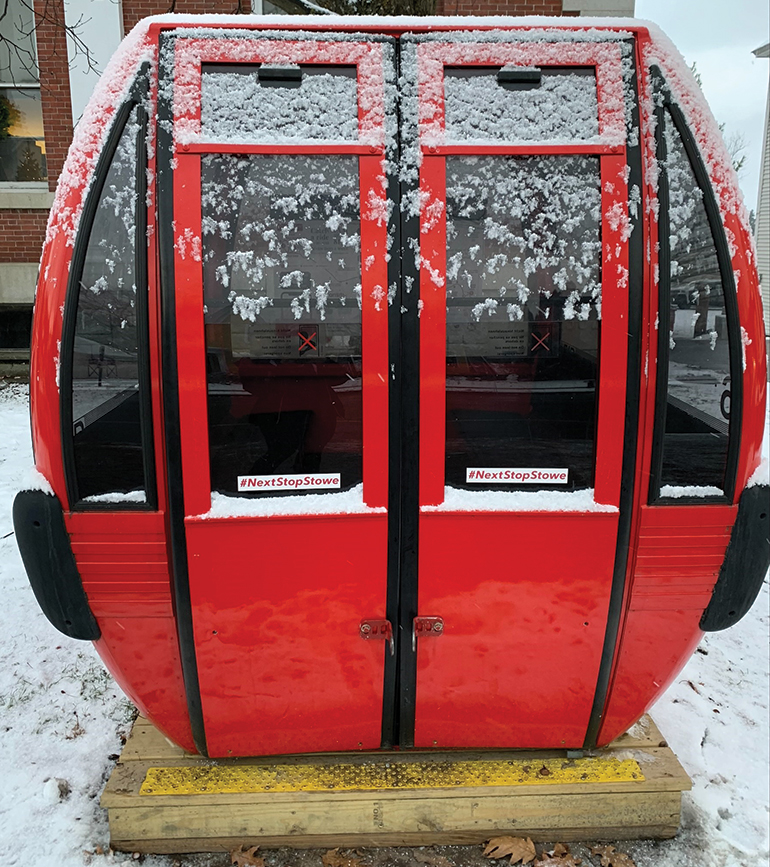
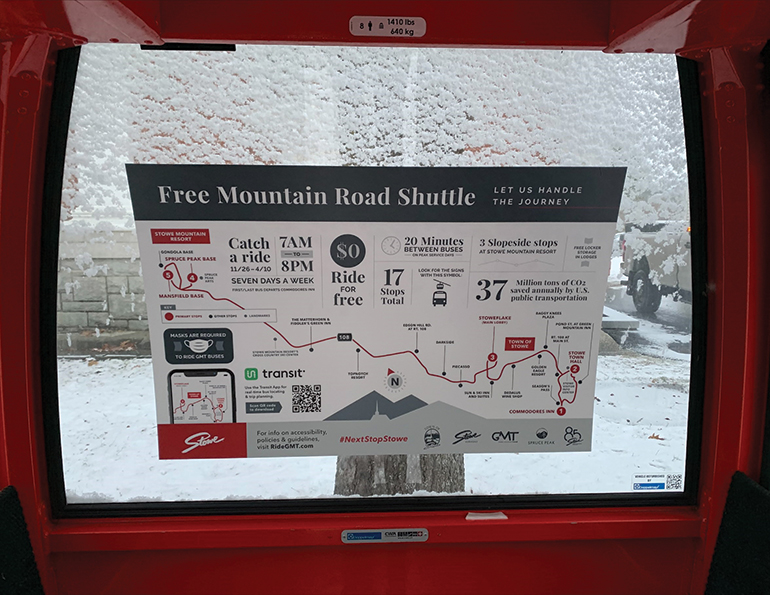 Stowe is encouraging shuttle use on the access road with a gondola bus stop in town while nearby signage educates visitors about the shuttle’s schedule and stops.
Stowe is encouraging shuttle use on the access road with a gondola bus stop in town while nearby signage educates visitors about the shuttle’s schedule and stops.
LOOKING TO THE FUTURE
In some cases, improving ski area access requires a broad approach to more efficiently moving large numbers of people. For years, discussion in Utah has focused on one notorious bottleneck—Little Cottonwood Canyon. More so than neighboring Big Cottonwood Canyon, which doesn’t have the same avalanche control issues, and Park City, which has a robust bus system, Little Cottonwood is frequently plagued with congestion and weather closures. Now, a means of addressing the problem finally seems at hand.
Infrastructure changes. After going through an Environmental Impact Statement with an extensive public comment period, Utah’s Department of Transportation is close to deciding between two proposed solutions: widening the road and increasing bus service, or building a gondola that would run eight miles from the base of the canyon to Alta. Each gondola car would fit up to 30 people for the 37-minute ride, including a stop at Snowbird. Vehicles could still drive up the canyon, but would have to pay a toll.
The ski areas favor the latter solution. “The gondola is the only option that takes weather out of the picture,” says Alta GM Mike Maughan. Ski Utah president and CEO Nathan Rafferty concurs: “Widening the road and adding more cars is just a bigger Band-Aid to this problem we’ve been faced with for decades.”
Not everyone agrees, including the mayor of Salt Lake County. Opponents cite cost, unsightly infrastructure, and too targeted a user group among the negatives. “The gondola isn’t a perfect solution,” says Rafferty. “Nobody loves the idea of the visual impact it would have.” And the estimated cost of installation is around half a billion dollars.
If greenlit, the gondola would be another three to five years from completion. “I’d like to think that a lot of other places would look at it as a solution,” says Rafferty. “It’s hard to separate Americans from their cars and to get transportation companies to think of things other than buses.”
New people-moving solutions. Though some may consider an eight-mile-long gondola an innovative way to move guests around, even more inventive options loom on the horizon. A New Zealand–based engineering firm with offices in Colorado, Holmes Solutions, is drawing on its work in the adventure recreation industry to efficiently transport people.
A proprietary system known as Whoosh will leverage technology Holmes has developed for rides—a trolley that transitions from cable to rail (and back)—on a grander scale. The system utilizes electric, self-driving pods that seat up to six people and can move in any direction, including up and down, on an elevated network of rails and cables. The pods reach speeds of 30 miles per hour and communicate with each other via smart controls. The easily expandable network is “like elevated roads, but with minimal infrastructure,” says Dan Brennan, Holmes Solutions director of business development for adventure recreation.
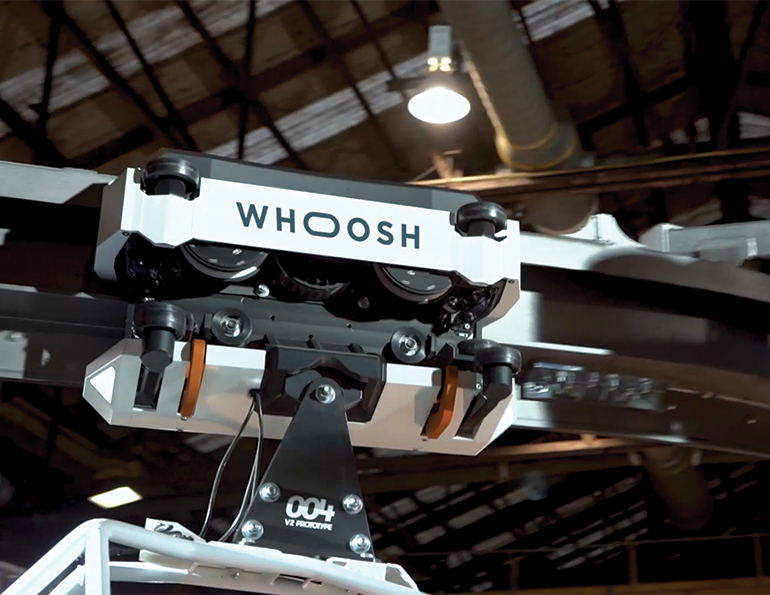 Holmes Solutions’ Whoosh technology offers a vision of the future with self driving pods that can transition from cable to rail to move people around with minimal infrastructure.
Holmes Solutions’ Whoosh technology offers a vision of the future with self driving pods that can transition from cable to rail to move people around with minimal infrastructure.
The company is currently designing a pilot project in Queenstown, New Zealand, that will use Whoosh to move people among locations in a two-mile first phase; construction will start in 2022, with an estimated two years until pods are operating on the network. Brennan says construction of a Whoosh system runs $3 million–$5 million per mile.
Could it work at ski areas? “Many resorts have long access roads that aren’t going to widen,” notes Crystal Mountain’s Sutner, “and this would allow them to use the existing infrastructure more efficiently.” Whoosh could move guests from outlying parking lots or even a nearby town to the mountain, for example.
The near future. For now, the most effective solutions to keep traffic flowing and mountains accessible may be multipronged approaches like that at Crystal—which even appointed a parking and transportation manager—or Eldora. “It’s not just a magic bullet for one season,” says Bass of Eldora’s plan. “Finding alternative ways to get people to the mountain has been developed over five years.”
As for Crystal’s notably comprehensive program, says DeBerry, “We really tried to think of all the bases and make sure that what we’re doing is not restricting people’s ability to get to the mountain, but offer a way for skiers and riders to join in on the effort. We all have to work together to make this happen.”





